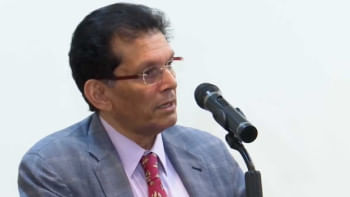Boro Harvest: Labour crisis worries farmers
The labour shortage created by the current shutdown is worrying farmers ahead of the Boro paddy harvest, despite different measures taken by the government to ensure maximum crop yield.
Although the agricultural ministry is making special arrangements for transportation of labourers from different districts to the country's granaries, labour leaders are unwilling to leave home fearing coronavirus infection.
Even the ministry's sanctioning of Tk 110 crore to help farmers buy harvester machines at a subsidy might do little to ease the crisis as small and marginalised rice producers, especially in the haor region, cannot afford such investments.
Harvest of Boro paddy, the principal crop of the country, starts in the haor region in a week, in the Chalanbeel area of the north in two weeks and in other parts of the country in May, agriculturists and farmers say.
Every year, farm labourers from different regions, particularly from Rangpur, Rajshahi, Dhaka, and Barishal divisions, go to the haors to harvest boro before flash floods inundate the area by the end of April.
The labourers then rush to the Chalan Beel area, other plain lands and Barind region for the same work.
But this year, farmer Akbar Hossain from the haor area of Sunamganj district's Jamalganj upazila could not find any labourer with just a week left before the harvest of his boro paddy, cultivated on 50 acres of land.
"No labour leader could assure me of anything. If I can't find labourers, the flood will wash away my paddy," he feared.
Ali Hossain, a farmer of Chalan Beel are in Natore's Shingra, cultivated boro paddy on 31 acres of land. He needs 25 labourers for seven days for harvesting his paddy at the end of this month.
"I am very worried. I have become tired of calling the labourers. None assured me of coming to work," he said.
Labourer Abdus Samad from Pabna's Chatmohor wants to go to Shingra for the harvest but could not find any vehicle.
Labour leader Bhabani Kanta Sen of Patgram in Lalmonirhat district is also facing the same problem. He has been travelling to haor areas of Sylhet division during every boro harvest for the last one decade and leads a group of 20 farm hands for the last couple of years.
"I never witnessed a situation like this. Most of us are afraid of visiting the haors of Sylhet as we think that area is risky [for virus infection]," he said.
"We can't go out of our village [under law enforcers' watch]. No vehicles are plying on the roads," Bhabani said, adding that they also do not have the money to travel.
Each labourer of Bhabani's group used to earn around Tk 30,000 working for 25 days during the harvest. But this year, Bhanbani is willing to let go of the income.
"Lives are more valuable than money. We can earn money if we survive," he said.
MEASURES BY MINISTRY
Officials of the Department of Agricultural Extension (DAE), however, said they are providing safe transportation to agricultural workers.
Director General Md Abdul Muyeed of DAE informed The Daily Star that in the second week of April they have already transported around 200 labourers from Rangpur and Pabna to the haor areas of Sylhet following health safety measures by keeping them at distance in buses and providing them with masks.
But Md Safar Uddin, DAE deputy director of Sunamganj district, said the initiative for transporting labourers from outside the Sylhet region was discouraged in a meeting on April 6 to stem coronavirus spread.
The district administration officials noted in the meeting that maintaining social distancing would be difficult if the DAE ventures to bring labourers from other districts, he said.
However, it was endorsed that the currently unemployed labourers of stone and sand quarries as well as coal labourers can be engaged in agricultural work, he added.
Secretary Md Nasiruzzaman of the agriculture minstry also feels that local non-agricultural workers, who have become unemployed due to the shutdown, will fill the labour shortage gap.
Talking to The Daily Star, he said, labourers, who work at the cities and returned home following the Covid-19 outbreak, are basically from agriculture sector.
They will work in crop fields in their locality as the cities have no jobs for them, he said.
Regarding labour transportation from other districts, Nasiruzzaman said local administrations were asked to allow movements of vehicles carrying agricultural labourers when harvest begins in different regions.
"We are identifying the labour leaders and asking them to hire labourers," he said, adding that for the uninterrupted movement of labour during the shutdown labour leaders shall be provided with a certificate detailing their travel destinations and number of workers under them.
The ministry of agriculture issued a circular in this regard on April 9.
The ministry also allocated Tk 110 crore to help farmers buy 800-plus combine harvesters, and 400 reapers and transplanters with subsidy this year. Of those, 180 new harvesters and 137 new reapers would be given to farmers in haor areas, that already have 362 harvesters and 1056 reapers.
A combined harvester can harvest paddy from 1.2 acres of land in an hour while a reaper is capable of harvesting 0.4 acres of land per hour.
Farmers would buy the machines while the government would provide 50 percent of the cost with the sanctioned money, the agriculture secretary said.
"Farmers of haor region are usually not interested in buying harvesters as they need it only once a year. So we will bring the machines from other districts to support them," he said, adding that similar steps will be taken in other regions.
CASH CRUNCH
Despite such assurance from the agriculture ministry, farmers in haors, Chalan Beel and the Barind regions cannot relax.
Jyotimohon Das of Sunamganj haor area cultivated boro on 6.8 acres of land and is worried about paying labourers' wages.
"Every year I borrow to pay off labourers with cash as they don't accept paddy in payment for difficulties in transportation. This time the lenders are not willing to provide loans. They say they don't have money," Jyotimohon said.
Jahangir Alam Shah, a farmer who opened a farming library in Naogaon's Manda, said small and marginalised farmers often sell paddy directly from the field to pay off the labourers and lenders.
However, he is anticipating a fall in paddy prices as he could not find buyers for his future produce yet.
Citing the coronavirus situation, the buyers are not getting into any contract and some are offering to buy paddy on credit, he said.
Nirod Boron Saha, president of Naogaon Paddy and Rice Businessmen's Association, said they are facing some financial constraints, but it would not impact their paddy purchase if the crop is available.
"Our main concern is who will harvest the paddy if labourers are not available," he said.
Even well-off farmers like Saidur Rahman of Sunamganj's Dharmapasha upazila are worried about higher production costs. He fears local peasants, who work as farm labourers, would demand higher wages this year.
At present, he added, the daily wage for agriculture labour is around Tk 400 to Tk 500, but it will double during the harvest time.
According to Bangladesh Bureau of Statistics (BBS) data, the country has a total 165.63 lakh farmers. Of them, 78.62 percent are small and 6.83 percent are marginal farmers. The number of farm labourer families is 90.96 lakh, accounting for 25.6 percent of the 3.55 crore total households in Bangladesh.
THE PRINCIPAL CROP
Paddy is cultivated on 71 percent of the total 1.54 crore hectares of cropland in the country, according to official data.
Boro accounts for more than half of the total 3.64 crore tonnes of rice produced in the country in the 2018-2019 fiscal year, BBS data shows.
Rajshahi division provides 18 percent of total rice production, while Rangpur and Dhaka divisions each provide 17 percent, Mymensingh 14 percent, Khulna and Chattogram each 13 percent, Sylhet five percent and Barishal division three percent.
Mymensingh tops among the rice producing districts followed by Naogaon, Bogura, Dinajpur, Tangail, Jessore, Cumilla, Sirajganj, Rangpur, Netrokona, Jamalpur, Kishoreganj, Gaibandha and Chandpur.
For the last two years, farmers have not been getting expected prices for their boro crop. As a result, this year the crop was planted on only 47.54 lakh hectares of land instead of 48.66 hectares of land as expected by the DAE.
Yet, DAE and Bangladesh Rice Research Institute officials are expecting a production of at least two crore tons of boro rice this year.
[Dwoha Chowdhury from Sylhet, S Dilip Roy from Lalmonirhat, Dipanker Roy from Khulna, Mostafa Yousuf from Chattogram, Aminul Islam from Mymensingh and Susanta Gosh from Barishal contributed to the report]

 For all latest news, follow The Daily Star's Google News channel.
For all latest news, follow The Daily Star's Google News channel. 



Comments